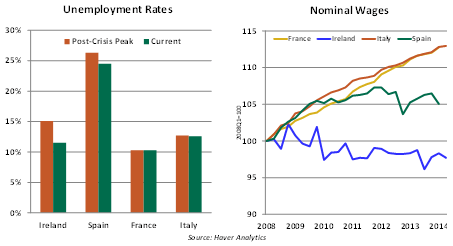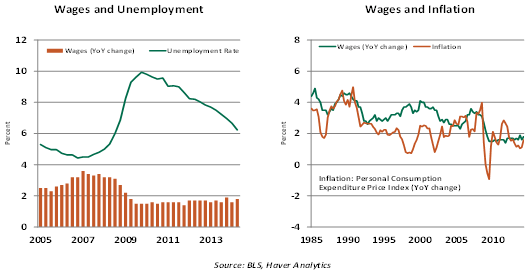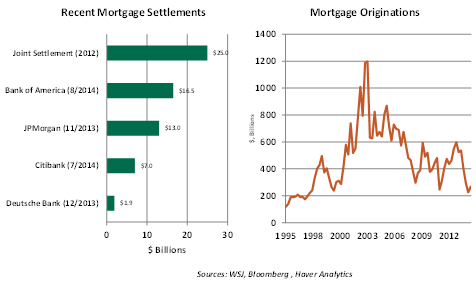- Flexible labor markets are key to recovering from recession
- Wage trends present a challenge for the Fed
- Bank settlements are sizeable, but the benefit to housing has been limited
As economists seek to understand the reasons for the world’s lingering unemployment, they’ve correctly noted that slow growth is one of the root causes. Central banks are using low interest rates and quantitative easing programs to address this. Mismatches between workers’ skills and the openings that exist can prolong the transition to new jobs. Additional training can close these gaps, but the process can take time.
Labor market "rigidities" are often blamed for making a challenging situation worse, especially in Europe. What are these inflexibilities, and how pressing are they? With central banks testing the edges of their effectiveness, labor market progress may depend critically on policy-makers’ willingness and ability to break down these structural impediments.
Labor and capital are the two classic inputs to economic output. (Capital, in this context, refers to physical and financial capital and also to those who own it.) Sometimes substitutable and always competing for a bigger share of national income, the two factors are often at odds.
Governments have passed labor laws to regulate the interaction of firms and workers. At a basic level, these rules proscribe unfair and unsafe practices. Child labor limitations, prohibitions against discrimination and workplace safety requirements are examples.
At a secondary level, some labor rules aim for an equitable distribution of prosperity. Minimum wages, mandatory collective bargaining and restrictions on the use of part-time workers fall into this category. In addition, firms are often required to go through a lengthy process before downsizing and are required to pay severance or premiums on unemployment insurance.
 Some countries have much greater restrictions on staffing reductions. Yet instead of keeping unemployment down, guidelines of this kind can have the opposite effect. Firms aware of how hard it is to adjust staffing levels once workers are hired may hesitate to hire in the first place.
Some countries have much greater restrictions on staffing reductions. Yet instead of keeping unemployment down, guidelines of this kind can have the opposite effect. Firms aware of how hard it is to adjust staffing levels once workers are hired may hesitate to hire in the first place.
Licensing requirements are another hindrance to labor market dynamism. Workers seeking to move from industries that are shrinking to those that are growing are often required to earn a new certification. Systems like this are rooted in good intentions: we like to know that the person working on our sink has background as a plumber and that the person working on our heart has background as a surgeon.
But some think that professions have used certification to limit labor supply and thereby protect wages. States are sometimes accessories to this trend, as they earn income for conferring the proper designations. Studies have shown that an increasing number of professions require some kind of license; such systems slow the transition from one job to another.
Finally, governments set long lists of rules for firms to follow and levy taxes that they must pay. Again, while these features are well-intentioned, they nonetheless serve as a disincentive for the formation and growth of young firms. During economic inflection points, small companies have often been a leading engine of job creation.
Mario Draghi, president of the European Central Bank (ECB), observed in his Jackson Hole, Wyoming, speech that "…economies that have weathered the crisis best in terms of employment tend also to be those with more flexibility in the labour market to adjust to economic conditions." He praised Spain and Ireland, which have recently seen nice declines in their jobless rates.
Under its support agreement with the International Monetary Fund (IMF), Ireland was required to actively reduce pay and pensions in many sectors. Spain agreed to relax some of the wage and workplace practices in its auto industry, a measure which attracted important amounts of new auto production. While painful, changing rules to allow wage adjustments resulted in a shorter return to equilibrium. France and Italy are being asked to take note.

To economists, anything that keeps the labor market from finding equilibrium must be viewed with some trepidation. No matter how noble the motivation, measures that limit the supply and demand for workers will result in lower levels of employment. This can be viewed as a social cost, which must be weighed against the social benefits of various labor laws.
 Different countries strike this balance differently. At the extremes are what the IMF calls an "Anglo-Saxon" model, which has low employment protection, and a "continental" model that has high employment protection. These are predicated on very different views about what defines success for companies: is maximizing shareholder value the sole driving principle, or are companies jointly “owned” by their stockholders, their workers, their clients and their communities?
Different countries strike this balance differently. At the extremes are what the IMF calls an "Anglo-Saxon" model, which has low employment protection, and a "continental" model that has high employment protection. These are predicated on very different views about what defines success for companies: is maximizing shareholder value the sole driving principle, or are companies jointly “owned” by their stockholders, their workers, their clients and their communities?
Reforming European labor markets has been exceptionally difficult because it is forcing nations to re-evaluate the relationship between labor and capital. Wages and benefits will have to moderate. And because change is seen as being forced by outsiders, resistance is higher.
Ultimately, however, neither firms nor workers profit from a shrinking pie. Unless the two sides can put away the long knives and focus more on the baking and less on the slicing, the ECB’s efforts may ultimately prove fruitless.
The Wage Conundrum
Fed Chair Janet Yellen’s speech in Jackson Hole last week highlighted a series of labor market issues that will influence the implementation of monetary policy in the months ahead.
One of them is the fact that employment compensation measures are hovering significantly below pre-crisis levels, while hiring continues to advance. Increases in U.S. wages have held around 2.0% for three straight years, as the unemployment rate fell to 6.2% from 9.0%. What explains the discrepancy between weak wage growth and improving employment conditions?

As the unemployment rate climbed rapidly and the economy moved into a deep recession, wage gains confronted their zero lower bound. Because wage levels could not decline, there arose what Yellen called “pent-up wage deflation.” Now, as the economy improves, wages may move up only gradually as the demand for labor advances.
If pent-up wage deflation is putting a cap on pay increases, then wage trends are not a good indicator of the extent of slack in the labor market. Moreover, when wages begin to advance, the acceleration could be swift, and the Fed’s monetary policy actions could be late. Therefore, assessing the signal from wages is a bit tricky.
Wage trends also reflect structural changes, such as the aging of the labor force and "job polarization." Job polarization is a situation in which workers with certain skills lose ground and demand for their labor declines, while demand for workers with other skills increases.
 Economists classify occupations as routine, abstract and manual. Research from the Federal Reserve Bank of Cleveland indicates that routine tasks accounted for about two-thirds of total employment in the United States in 1976. But by the end of 2013, it had fallen to roughly 50%. During this period, the share of abstract tasks rose to 40% from 28%.
Economists classify occupations as routine, abstract and manual. Research from the Federal Reserve Bank of Cleveland indicates that routine tasks accounted for about two-thirds of total employment in the United States in 1976. But by the end of 2013, it had fallen to roughly 50%. During this period, the share of abstract tasks rose to 40% from 28%.
The reduction in routine occupations is not new, but job polarization has risen disproportionately in the recent decade and stands out in part-time employment data. The bottom line is that job polarization has resulted in a loss of a number of middle-skill jobs and is an important structural issue that has a place in monetary policy discussions.
Inflation leads wages in many cases. If the Fed uses wage gains to dictate monetary policy changes, its policy actions to contain inflation may begin late. The elements of job polarization and pent up wage deflation have complicated things by altering the lead-lag relationship between inflation and wages in the present situation.
For now, the Fed’s preferred inflation measures are holding below the target rate, wage growth is contained and the Fed judges that “underutilization of labor resources still remains significant.” But labor market complexities enhance the degree of uncertainty around monetary policy actions.
Closing the Books
The philosopher Sun Tzu observed that, “Wheels of justice grind slow, but grind fine.” That is an appropriate way of describing the process of penalizing banks that behaved less honorably during the buildup to the global financial crisis.
Underwriters who sold faulty mortgages and securitizers who packaged them into bonds have gradually been called to account for their actions. The settlement agreed to between Bank of America and the Justice Department earlier this month raises total industry retribution to well over $100 billion. Some of this amount has been in the form of cash fines, while the remainder has been set aside in pools to provide relief to the aggrieved.
There are certainly those who feel that authorities have been overly punitive, but the dollars involved are a small fraction of the losses endured by homeowners and investors. All the firms involved had sufficient capital and reserves to handle the settlements, and several saw their stock prices improve as the cloud of legal uncertainty lifted.

These latter points have provided fodder to those who think the authorities have been too lenient. Some would like to see a few leading bankers indicted or at least defrocked. The debate over whether the financial consequences were large enough to send the right message to underwriters could go on for a long time.
 But those engaged in these debates may be overlooking an overarching objective of the process: healing the housing market. Mortgage originations have diminished, and residential investment is growing slowly. The fraction of homeowners with negative equity remains at 17%. This weighs on real estate prices, limits labor market mobility and impairs consumer spending.
But those engaged in these debates may be overlooking an overarching objective of the process: healing the housing market. Mortgage originations have diminished, and residential investment is growing slowly. The fraction of homeowners with negative equity remains at 17%. This weighs on real estate prices, limits labor market mobility and impairs consumer spending.
Public and private programs to reduce the burden of housing debt have progressed very slowly. There have certainly been some procedural issues to overcome, but industry settlements should provide plenty of financing for the effort.
The penalties certainly help to outline the kind of mortgage market that we don’t want, but we’re still struggling to define the new normal for housing finance. New rules designed to make mortgage lending safer are nonetheless limiting the industry. And the uncertainty over legal liability not only deters bad business practices but also underwriting in general.
It’s certainly taken a long time to get to this point. Now that the blame has been fixed, let’s hope that we can proceed to fix the problem.
Recommended Content
Editors’ Picks
EUR/USD holds steady near 1.0650 amid risk reset

EUR/USD is holding onto its recovery mode near 1.0650 in European trading on Friday. A recovery in risk sentiment is helping the pair, as the safe-haven US Dollar pares gains. Earlier today, reports of an Israeli strike inside Iran spooked markets.
GBP/USD recovers toward 1.2450 after UK Retail Sales data

GBP/USD is rebounding toward 1.2450 in early Europe on Friday, having tested 1.2400 after the UK Retail Sales volumes stagnated again in March, The pair recovers in tandem with risk sentiment, as traders take account of the likely Israel's missile strikes on Iran.
Gold price defends gains below $2,400 as geopolitical risks linger

Gold price is trading below $2,400 in European trading on Friday, holding its retreat from a fresh five-day high of $2,418. Despite the pullback, Gold price remains on track to book the fifth weekly gain in a row, supported by lingering Middle East geopolitical risks.
Bitcoin Weekly Forecast: BTC post-halving rally could be partially priced in Premium

Bitcoin price shows no signs of directional bias while it holds above $60,000. The fourth BTC halving is partially priced in, according to Deutsche Bank’s research.
Geopolitics once again take centre stage, as UK Retail Sales wither

Nearly a week to the day when Iran sent drones and missiles into Israel, Israel has retaliated and sent a missile into Iran. The initial reports caused a large uptick in the oil price.